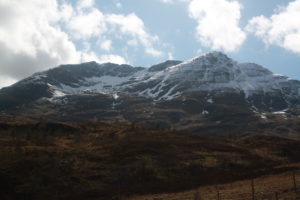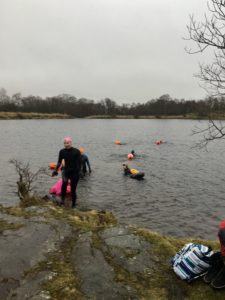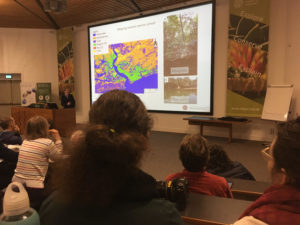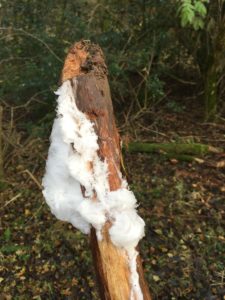I’m pleased to have got an honorable mention in the Mountaineering Scotland annual writing competition, for this bit of writing that’s a bit more personal than my usual material. Fourth place didn’t come with a prize or publication, but it’s no’ bad.
No word from Raven Crag
Remembered: Ice-cold alloy gear sticking to my hands, and to the frozen ground. Just at dawn, the small car park at Thorneythwaite Farm, on a dry, snow-free February day, in the old days when I lived south of the Border.
Today, it’s the end of March. The same path for Glaramara leads up into scrubby woodland, thorn trees, bracken. I see the magnified beauty, the pretty detail and handsome hillsides of Borrowdale, the green, lush, stone-walled farmland bordering straight onto the craggy steepness, the peopled landscape edged by mountain piles. It’s a far cry from the cleared glens of my adopted home.
We’ve forgotten the water bottle, so the lad dashes back for it, and while I wait I recall our heavy-laden walk up this path. She had the rope and I had the gear, up and into the combe, crisp blue sky and rock-hard ground, a hint of anxiety at tackling a long mountain rock route, however easy, in freezing February.
There was verglas on the first pitch and we pulled it off with our hands. After that our timing seemed perfect as the sun came onto the face, instantly warming, relief to chilly hands and cold rock.
In those days the hawthorn tree next to where I sit was probably a strong young tree. Now it’s open on one side, a decaying core exposed, but on each side of it two sturdy strands have grown up like curled banister rails, its strength recovered.
There’s rich orange bark on another tree, curiously whorled and shaped around a hole made perfectly for some animal or bird to raise a family.
He’s back, and we walk on in my old footsteps, he with a long flaming mane of hair – I was the same at that age – and easy stride. I try to push the pace, but I’m the only one panting.
As the path for Glaramara rises we sidle off on the small track into the bottom of the combe, at first heading right, towards the big crag. My memory is of rough dark rock, always with a hold to go for – we whooped with joy at the hand traverse, so much exposure and excitement for an easy grade.
But the well-worn old climb is topped with cloud today, and the sun is slipping away from it. Changing plan seems simple here compared to home, with all these fine rough mountain crags to head for, charted and laced with climbs, a star here, three stars there, inviting and tempting us to sport.
Ahead now to our left is the rock-slip buttress, complicated and pinnacled, pale and dry with the slight silver-watered sun gleaming onto it.
We reach the lowest rocks, gear up, and I lead an entry pitch to a stance amidst holes, pinnacles, slots and boulders. From the broad belay I have time to watch a pair on the buttress opposite, hoping to catch them on the hand traverse and maybe hear the whoop again.
He comes through and takes his time to carefully step up onto the hanging slab above, but then his progress is swift and easy.
I know he’s fine, and I have always lived in the belief that a life without risk and challenge is no life at all. I love that he climbs, and is steady and competent, but you can’t help fearing for them. “Time for a bit of gear, son?â€
That last time: she led out in her turn, confident and smiling. The choice was justified, the risks were right, it was a perfect day, rising all the while up the narrow band of clean rock.
And at the top we coiled the ropes in grins and hugs, sunshine and easy companionship. How could we have known then what was to come? No terrible fall, no crippling hate, just life making it harder to get back to those perfect days: kids, jobs, houses, tiredness, changing hearts, changing focus …
The lad is belayed in a small cave and I step up onto the arête above, easy climbing but no gear, to top another pinnacle and face the final small obstacle, a tough little corner, awkward and smeary, a guessing game for the higher holds. I guess right and with an awkward pull I’m through it, and onto the top.
Belay on, I take in. He’s fast up it and I hear voices floating from the combe below, but no word from Raven Crag. It’s too distant and the wind is blowing towards it, to whip away stray sounds.
We coil the rope, and when I look over the other pair have topped out and are clear in profile right above the climb, heading back along the ridge, the well-remembered walk with views across and down, hard-rocked hills and green dales all around, a view to make a life for.
Did we warm ourselves by a cottage fire that night, did we camp and head for the pub? I can’t recall the rest of that old day, blurred into so many Lakeland trips, but those crystal moments remain, the pure unmixed pleasure and intensity of a climb with someone I love.
Now we’re on another route, on the slab on the left of the crag, and he steps neatly through the overlap. He’s unprotected and I look away, then gear slips into place and he follows the break up and into the final groove. It’s a long pitch and I know we packed for easier climbing, but he never complains, just eases himself over the lip to the stance at the top.
He builds a perfect belay – engineering is now his profession – and I struggle up the overlap, before trying to regain my dignity on the rest of the pitch.
We walk back down the combe in a light, soaking drizzle, delighted to have got it right again, beaten the weather, had the best of the day. There is a warm tightness in my heart, pure, unmixed pleasure and intensity.
That past sits sit easy now too, unsullied by what followed: the gall is gone, replaced by a soft, sweet sadness and a memory of the best of times. After all, when life is short, what’s the point in remembering the hard, rough, tear-filled days that ended in my flight to the north?
Tonight the lad is good company, and when we get our pints I drink a self-conscious but heart-felt toast: “To the good times.â€
And I hope there will be many more, for me in my life, for her in hers, but especially for our children.








